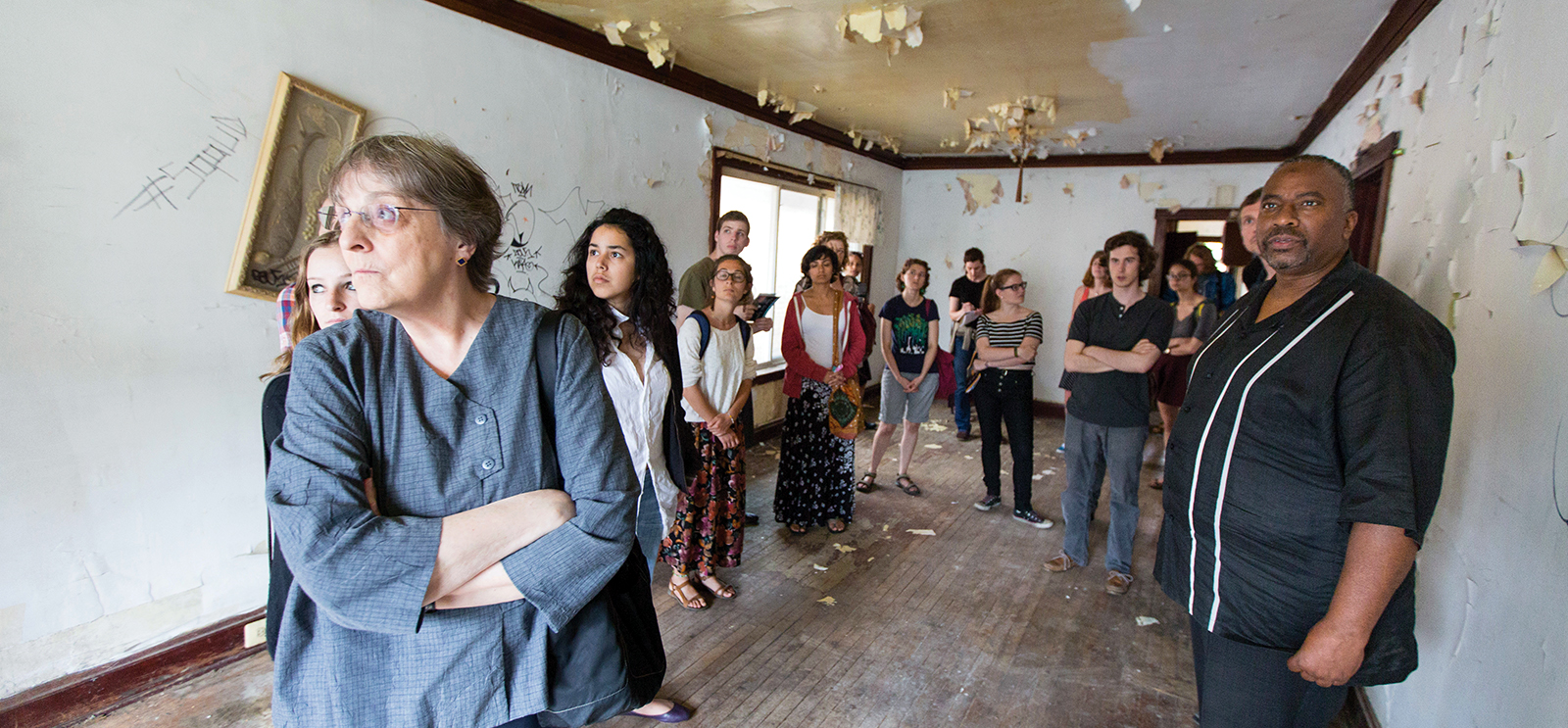
A Study Chicago excursion to Marquette Park and Englewood.
Last spring the College ran the Study Chicago quarter for the first time. Inspired by the College’s Study Abroad offerings, the Study Chicago program included courses in history, literature, and public policy, as well as group excursions on Fridays.
The bus is late.
It’s a hot, sticky May afternoon. Study Chicago students mill around in front of the Regenstein Library, the meeting point for Friday excursions. An ice cream truck pulls up; several of the students decide they might as well buy treats.
Finally a substitute bus arrives. Not a school bus—the group’s favored transportation “because they’re invisible,” as Chad Broughton, AM’97, PhD’01, of the Study Chicago program puts it. School buses can go anywhere in the city and no one notices.
This is a deluxe tour bus with “Infinity Transportation: Excellence, Elegance, and Experience on Wheels” painted on the side. Not exactly ideal for a trip to some of the poorest neighborhoods in Chicago. (“The worst decision anyone could have made,” Katherine Aanensen, Class of 2016, says later.)
But there’s no other option. The group boards the bus.
As it heads west on Garfield Boulevard, Broughton points out landmarks. The Green Line, built to bring visitors to the 1893 World’s Columbian Exposition. The Arts Incubator, run by conceptual artist Theaster Gates. The gorgeous 1914 Schulze Baking Company plant. Sherman Park, which marks the northeast edge of Englewood.
The vacant lots between the buildings look like meadows, thick with dandelions. Several students call out “Harold’s!” as the bus passes one of the ubiquitous chicken shacks. “Harold’s is brain food,” a student observes.
The bus stops briefly outside the nonprofit Growing Home, an organic farm that provides job training. The doors to the greenhouse are open on this warm spring day. From the bus, it looks like they’re growing spinach and other greens.
Then it’s on to the Inner-City Muslim Action Network (IMAN) on West 63rd Street. The word iman means “faith” in Arabic.
Founded by Rami Nashashibi, AM’98, PhD’11, in 1997, the organization is just blocks from Marquette Park. The park is doubly notorious as the site where Martin Luther King Jr. was hit with a brick in 1966 and where neo-Nazis held regular marches in the 1970s.
In the meeting room, speaker after speaker explains IMAN’s wide-ranging community programs: a farmers’ market, a youth and wellness space, an annual hip-hop festival. The building houses a health center. A dental suite is coming soon.
Some of IMAN’s programs are groundbreaking. Muslim Run, for example, is intended to build trust between Muslim owners of corner shops and their African American customers.
Muslim Run encourages store owners to stock more fresh, healthy food, while educating customers on nutrition. The program includes Corner Store Cyphers, impromptu hip-hop performances outside Muslim-owned stores.
“We want to radically reimagine the corner store from a site of racial tension to a site of creativity,” says youth and arts manager Sadia Nawab, who wears a sparkly black headscarf. Nawab learned to deejay when she joined IMAN’s Digital Media Masters program eight years ago, at age 17. “I’ve always seen creativity as evidence of the Creator.”
After the presentation, Aanensen, seems entranced: “I kind of want to get involved with them.”
The next stop is an abandoned bungalow around the corner on South Fairfield. Participants in IMAN’s Green ReEntry program, who have spent time in prison, will learn carpentry skills by fixing it up. On the way, Chelsea Fine, Class of 2016, stops to snap photos of the stunning Renaissance revival St. Rita of Cascia church, at 6243 South Fairfield Avenue.
The students wander through the small bungalow. Its peeling walls are covered in Satan’s Disciples graffiti.
What if the gang members come back? someone asks. “Some of these guys are killers,” Green ReEntry coordinator Matthew Ramadan says matter-of-factly, meaning the men fixing up the house. “You don’t want to mess with them.”
Back to the all-too-visible bus—which actually isn’t drawing any attention at all. A walk through Marquette Park was planned, but it’s late and raining torrentially.
Instead the bus circles through the park and then heads back east to the Greater Englewood Community Development Corporation (GECDC). It’s headquartered in a grand 1930s Art Deco bank on the corner of 63rd and Halsted.
“What comes to mind when you think about Englewood?” Glen Fulton, executive director of the GECDC, asks the students.
Their answers are quick and disheartening: “Violence.” “Poverty.” “Food desert.”
“All of the above is true,” he says. “We’re trying to change that mindset.”
Englewood used to be the second largest shopping district in Chicago outside of downtown, Fulton says. He asks if anyone in the group was alive in 1968. No hands go up. Even Broughton is too young.
In 1968, Fulton says, “I remember Martin Luther King being assassinated and Englewood burning” during the riots that followed. “By 1976 they had torn everything down. There was nothing here.”
But the GECDC is making no little plans. Whole Foods, Chipotle, and Starbucks are coming to 63rd and Halsted.
A call center with 1,200 jobs is coming too. A small business accelerator. And a technology training center for young people between the ages of 17 and 24. Right now the unemployment rate for Englewood residents in this age group is 84 percent.
In five years, Fulton promises, “You’re not going to know this community.”
